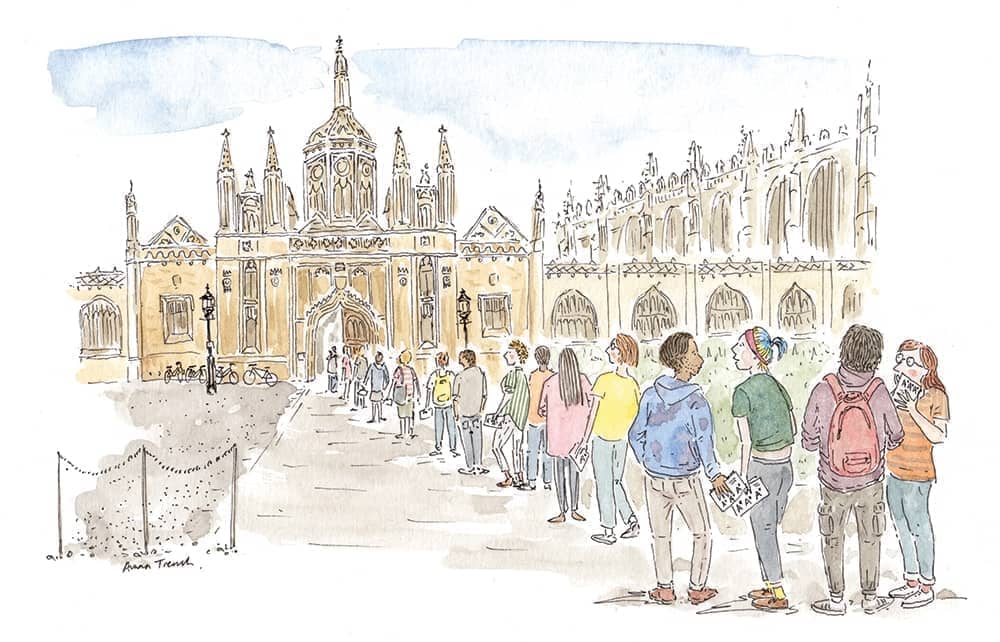Liz Truss suggests that all students who score straight A*s at A-level should be interviewed by Oxford or Cambridge. They, and their parents, might well wonder why they would not be summoned for an interview if they can achieve such impressive results. But it’s not that simple.
Post-A-level candidates are much fewer in number than pre-A-level ones, with most students offered places on the condition that they achieve the required grades. So various options have now been offered to address this. In one, all pupils predicted such grades would be eligible for an interview ahead of sitting their exams. However, it’s hard to see how teachers would resist the temptation to make generous predictions in order to catapult their pupils into interviews.
In the latest version of Team Truss’s policy, the university year would begin in January, so that A-level results could be made available before interviews in late summer and autumn. Objections are already mounting up. Other Russell Group universities are worried Oxbridge will pick the best cherries, and all universities would be furious at losing out on summer conference revenue if teaching continued throughout the summer months. But there is also the danger that universities might start choosing students on the basis of grades rather than the full profile of candidates, which is one advantage of having to make offers before the exams are taken. The best pupils do not win places solely on the basis of their grades: they have other attributes. Achievements away from the classroom also need to be taken into account – maybe the candidate has a high grade in violin, has directed a play, won a poetry prize, or has a passion for wildlife conservation. All told, these Oxbridge ideas are, at best, starting points, and they give the unfortunate impression that the whole system needs to be changed solely for the sake of two universities.
The issue of grade inflation cannot be avoided in any discussion over the proposed policy. Covid resulted in a spike in the number of top grades being dished out, following the cancellation of exams and teacher grade assessments being used in 2020 and 2021. The exams regulator Ofqual reports that last year, 12,865 students took and received three A*s, a marked increase from 2020 when the figure was 7,774; in 2019 it was 2,785 and in 2018 a mere 2,460. This means that nearly five times as many candidates secured straight A*s last year as had done only three years earlier. This rise might be taken as proof that what teachers are willing to say about the excellence of their students is often, shall we say, kind. This year’s decline in the number of straight A* grades – down to 8,570 – is therefore very welcome. Though it is still high by comparison with a few years ago.

What, then, is an A*? This itself reveals some of the idiosyncrasies of the exam system. The somewhat obscure definition is this: ‘The A* at A-level is awarded to candidates who achieve a grade A on the A-level overall (80 per cent), and who also achieve at least 90 per cent on the uniform mark scale (UMS) across their A2 units.’ Can one award 90 per cent in a subject like history or literature? Of course one can, if the exam becomes a test of making the required points in exactly the right way, often built around an established argument, a counter-argument and some sort of conclusion about which works better. The space for originality and ingenuity is squeezed. A-levels should not become a mechanical exercise.
Truss would do well to study the admissions statistics for Cambridge. These show that this academic year, 3,660 candidates were accepted, including 64 more women than men. There were 4,260 initial offers of places, subject to performance at A-level, this time with a slight male majority. But there were just under 23,000 applications, again with a male majority, meaning that there was a better than one in six chance of being selected.
Nowadays a significant minority of candidates are not invited for interview, and giving all prospective A* candidates the right to an interview would demand more teams of interviewers than can be found, even allowing for the fact that many (but not all) would have applied to Oxbridge in any case. Truss’s plan made no mention of how her policy would work in practice.
The Department for Education has published statistics for 2020-21, admittedly not typical, because of the pandemic. They are rich in detail about scores of ‘A and better’, but mysteriously don’t separate A* from a simple A. The main interest of these figures is the breakdown by ethnicity, which has to be qualified because nearly half of all candidates’ ethnicity is listed as ‘unknown’. We have to be exceptionally careful about ethnicity in this setting. Quotas exclude as well as include. Where it is identified, we find that among candidates of Chinese descent an impressive 42.2 per cent achieved three As/A*s in 2020-21, and among those of Indian descent it was 33.2 per cent. The lowest performers were Roma, at 10.8 per cent. Before grade inflation, 10.8 per cent would have been considered impressive.
The space for originality and ingenuity is squeezed. A-levels should not become a mechanical exercise
The Chinese figure quite closely matches the percentage of students of Chinese origin attending top universities, according to figures released by the DfE in July. This is strikingly different from the performance of white state school students at top universities, which now stands at 10.5 per cent, a little below the figure for black students (which, however, mixes up those of Caribbean and African origin, whose A-level performance differs, not to mention the frankly racist assumption that all black people are of a single ethnicity).
‘White’ here embraces all social backgrounds, but it is becoming obvious that disadvantaged whites, especially males, are losing out in the contest for places at top British universities. The question is whether this is the result of a failure to recognise poverty outside ethnic minorities, or of a contest to attract as many ethnic-minority students as possible and to treat all white students as the beneficiaries of what is sometimes termed ‘white privilege’. As a former equalities minister, Truss will be aware of such oversights. Perhaps it would be better to improve the quality of data before we start making decisions on how to change entry criteria.
For too long, the crude state vs independent divide has been used as the prime indicator of how much ‘progress’ universities are making in opening up to students from disadvantaged backgrounds. Any head of an independent school will point to the number of pupils with bursaries (something like 35 per cent), which can cover full fees, and to ambitious fundraising projects among alumni with a strong sense of the need to increase opportunities for new generations to benefit from the education they themselves received.
Even an increase in state-school entries is not a good enough target for advocates of social engineering such as Stephen Toope, the outgoing vice-chancellor of Cambridge. He has railed against the presence of so many students not just from private schools but from all selective schools. He notes that comprehensive schools do not fare well compared with selective state schools, such as grammars and sixth-form colleges. Although 71.6 per cent of all acceptances for UK applicants at Cambridge in 2020-21 came from maintained schools, the figure for comprehensives was 18.3 per cent and for grammars 24.8 per cent, while most of those in the sixth-form college category (18.7 per cent) attended a state school (undefined). The grammar school figure for the acceptance of students educated in the UK is, in fact, 4.1 per cent higher than the independent school figure (20.7 per cent). It comes as no surprise that schools with a competitive selection process fare better than those without. This can also apply in the independent sector, where St Paul’s and Westminster will outperform what a teacher at a famous but academically modest school once described to me as a ‘fee-paying comprehensive’, owing to its generous admissions policy.
These results are part of a shift away from independent schools, for good and bad reasons. Good in the sense that sterling efforts to attract more top candidates who would never have thought of applying are succeeding; bad that really excellent candidates from top schools are being passed over. A few are dumped in the pool where colleges not satisfied with the quality of those they have interviewed pick up strong candidates not offered a place by their college of first choice. In order for colleges to meet state school quotas – for that is what the ‘benchmarks’ have become’ – young men from independent schools who have been dumped in the pool have little chance of being saved from drowning. The problem is accentuated by the fact the universities to which these bright Oxbridge rejects migrate – Bristol, Durham, St Andrews – are also looking at their entrance statistics with a view to admitting a higher proportion of state school pupils.
As prime minister, Truss would have a golden opportunity to insist that university entrance is about excellence, not social engineering. And parents should focus on what schools offer, whatever type of school it is. I recently met some parents at an ancient and highly academic public school, not all either toffs or alumni. They were not set on their children going to Oxbridge but they knew that the school would equip them extremely well for life. After all, if you keep trying to look beyond the horizon you fail to see what treasures lie at your feet.






Comments